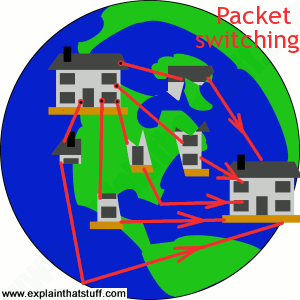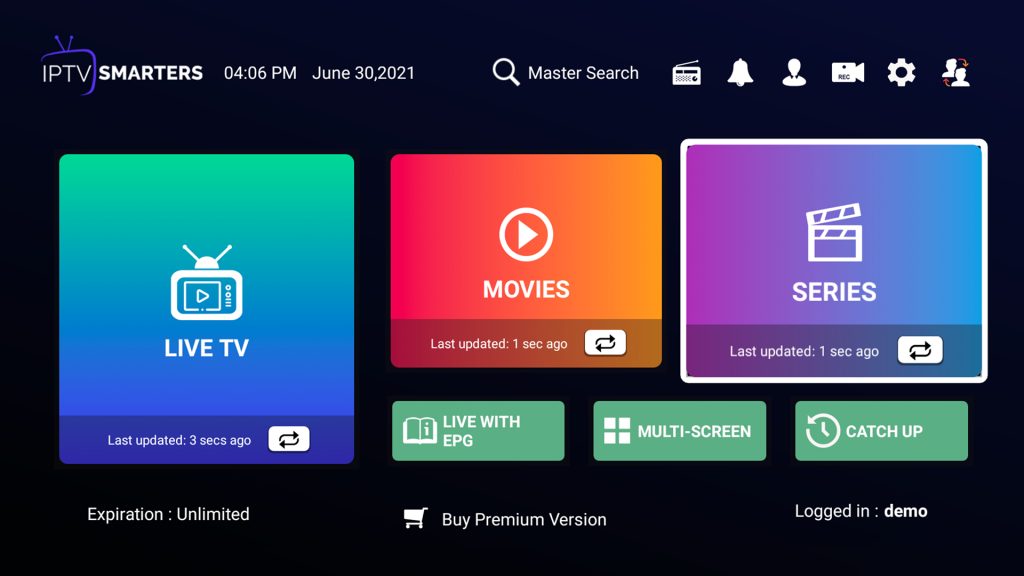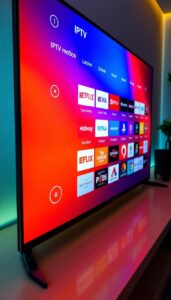All information about iptv
Why should someone you’ve never met decide what you can watch on TV and when you can watch it? True, there’s always a choice of channels, but the selection is still quite limited and unless you record programs in advance, you can only watch them when they’re broadcast. Wouldn’t it be better if watching TV were more like browsing the Web, so you could pick the program you wanted to watch whenever and wherever you felt like watching it? That’s one of the promises of IPTV (Internet Protocol Television), which uses Internet technology to deliver TV programs “on demand.” How does it work? What benefits will it bring us? What challenges will the broadcasters and telephone companies face delivering these new services? Let’s take a closer look!
Photo: IPTV… without the TV! Here I’m watching pay-as-you-go, video on demand on a large HD smartphone (a “phablet” somewhere between a phone and a tablet) using Amazon’s Instant Video (its answer to Netflix).
Contents
- What is IPTV?
- What is the “Internet Protocol” in IPTV?
- How does IPTV work?
- The future of broadcasting?
- Find out more
What is IPTV?
From a TV watcher’s point of view, IPTV is very simple: instead of receiving TV programs as broadcast signals that enter your home from a rooftop antenna, satellite dish, or fiber-optic cable, you get them streamed (downloaded and played almost simultaneously) through your Internet connection. Although IPTV can work on relatively slow ADSL broadband connections, which can probably handle only 1–10 Mbps (million bits per second—roughly the amount of information in an average novel entering your computer every second), it’s much better on fiber broadband lines with about 10 times higher bandwidth (information carrying capacity) of maybe 10–100Mbps. You watch the program either on your computer, a mobile device (like a smartphone), or with a set-top box (a kind of adapter that fits between your Internet connection and your existing television receiver, decoding incoming signals so your TV can display Internet programs).

Photo: A typical domestic IPTV setup. The Internet (1) connects to your home (2) in the usual way. Inside your home, your router (3) links to a set-top box (4), which converts IPTV signals into a format a regular TV (5) can process. Other digital devices, such as smartphones and tablets, can access IPTV direct from the router.
From the viewpoint of a broadcaster or telephone company, IPTV is somewhat more complex. You need a sophisticated storage system for all the videos you want to make available and a web-style interface that allows people to select the programs they want. Once a viewer has selected a program, you need to be able to encode the video file in a suitable format for streaming, encrypt it with what’s called digital rights management (DRM) (encoding it so only people who’ve paid can decode and receive it), embed advertisements (especially if the program is free), and stream it across the Internet to anything from one person to (potentially) thousands or millions of people at a time. Furthermore, you have to figure out how to do this to provide a consistently high-quality picture (especially if you’re delivering advertising with your programming—because that’s what your paying advertisers will certainly expect).
Three types of IPTV
IPTV comes in three different flavors.
- The first kind—and the one you’re probably using already—is called video on demand (VOD). With a service such as Netflix (an online movie website), you select a TV program or movie you want to watch from a wide range, pay your money, and watch it there and then.
- A different kind of IPTV is being offered by some of the world’s more enterprising TV broadcasters. In the UK, the BBC (British Broadcasting Corporation) makes its last week’s programs available online using a web-based streaming video player called the BBC iPlayer. This kind of service is sometimes called time-shifted IPTV, because you’re watching ordinary, scheduled broadcasts at a time that’s convenient for you.
- The third kind of IPTV involves broadcasting live TV programs across the Internet as they’re being watched—so it’s live IPTV or IP simulcasting.
All three forms of IPTV can work either using your computer and an ordinary web browser or (for much better quality) a set-top box and an ordinary digital TV. All three can be delivered either over the public Internet or through a managed, private network that works in essentially the same way (for example, from your telephone and Internet service provider to your home entirely through the provider’s network).

Personalized interactive TV
Traditional TV broadcasting means one-way, one-to-many delivery of information, but combining television and video pictures with the Internet opens up the possibility of a much more interactive experience where information flows in both directions. We’re already used to TV talent shows where people phone in to vote for their favorite acts, but in a future where TV programs are delivered online, we can expect far greater involvement in the programs we watch. Instead of TV presenters talking to a live audience of a few hundred people in a studio, they’ll be talking to a live audience of thousands or millions of viewers who can send instant feedback. We’ll be able to ask questions and have the presenter answer them minutes later! Or maybe we’ll vote on how we want TV soaps to play out, with multiple endings filmed in advance and different ones screened to different viewers!
If you’ve used VOD services, you might have noticed that some of them are already delivering interactive advertising: since you’re essentially just viewing a video in an ordinary web page, you can click on an advertisement to go to a website and find out more. Given the trend toward highly targeted, online behavioral advertising, advertisers will use IPTV to deliver advertisements that are much more relevant to the individuals who watch them. That’s going to prove more effective and attractive for them than the catch-all, generic ads they screen today on today’s broadcast TV channels, not least because may people record programs for later viewing and fast-forward over the ads (something you can’t do with IPTV). It’s very likely you’ll even be able to choose the advertisements you want to watch (“Only show me ads about fashion/sport”).
What is the “Internet Protocol” in IPTV?
IPTV stands for Internet Protocol TV—but what does “Internet Protocol” mean? It’s the essence of how the Internet works.
Send an email to a friend or download a web page and the information you set in motion doesn’t travel in one big lump, as you might expect. Instead, it’s broken up into lots of small pieces, known as packets, each of which may be “switched” (sent) to its destination by a different route. Packet switching, as this is known, is the basic principle of how any information travels over the Internet. The computers that link the Net together don’t know what any given packet means or what it does. All they know is the IP address (a numeric “house and street name” given to every computer on the Internet) where the packet has to go—and they treat all packets equally.

Artwork: Packet switching is the key to how the Internet works. It involves breaking up a piece of information and sending it in small pieces from its origin to its destination—a little bit like moving house by mailing all the bricks in separate envelopes. Read more about it in our article about the Internet.
The Internet isn’t designed to do a particular job, such as delivering emails: it’s simply a highly efficient, computerized “postal” system for delivering zillions of packets. The simple but amazing consequence of this is that as long as you can turn information into packets, you can send it over the Internet—whatever the information might be. That’s why the Internet can be used for sending emails, downloading web pages, making telephone calls (using a technology known as VoIP (Voice Over Internet Protocol), watching TV—and doing a dozen other things that have not yet been invented. If someone had designed the Internet more rigidly, purely for shuttling emails for example, using it for other things, such as telephone calls or TV, might not have been possible.
How does IPTV work?
With traditional TV, programs are broadcast by being turned into radio waves and beamed through the air to a rooftop antenna on your home. The antenna converts the waves back into electrical signals and your TV set decodes them to make its sound and picture (satellite TV works the same way, except the signal bounces into space and back, while cable TV sends the signal directly into your home without radio waves). How is IPTV different?
Storing programs
Live programs are streamed as they’re produced, but prerecorded programs and movies need to be stored in such a way that they can be selected and streamed on demand. Some VOD services limit the number of programs they make available not because they’re short of storage space but because that’s one way to limit the overall bandwidth of their service and its impact on the Internet. (For example, if the BBC made available every program it’s ever produced on its iPlayer, which is free to use, a significant proportion of the entire UK Internet bandwidth would be taken up streaming TV soap operas and sitcoms, potentially slowing down the network for every other kind of Net traffic.) [1]
Preparing programs
First, the TV program (either prerecorded or captured live with a video camera) has to be converted into a digital format that can be delivered as packets using the Internet protocol. Sometimes the original program will be in digital format already; sometimes it will be in the form of a standard, analog TV picture (known as SD format) that needs an extra bit of processing (analog-to-digital conversion) to turn it into digital format. With current limitations on bandwidth, videos also need to be compressed (made into smaller files) so they can stream smoothly without buffering (periodic delays caused as the receiver builds up incoming packets). In practice, this means programs are encoded in either MPEG2 or MPEG4 format (MPEG4 is a newer form of video compression that gives higher quality for a similar bandwidth and requires only half as much bandwidth for carrying an SD picture as MPEG2). Once that’s done, advertisements have to be inserted, and the information has to be encrypted. [2]
Streaming programs
When you browse a website, you’re effectively making a temporary link between two computers so one can “suck” information off another. Your computer (the client) pulls information off the other, typically much more powerful computer (the server) by linking directly to an IP address that corresponds to the website you want to look at. The client and server have a brief, intermittent conversation in which the client requests from the server all the files it needs to build the page you’re looking at. Servers are generally so fast and powerful that many clients can download in this way simultaneously, with very little delay. This kind of ordinary downloading between one client server and one server is known as IP unicasting (most web browsing falls into this category).
IP multicasting
When it comes to streaming (playing programs as you download them), however, the clients put a much greater (and simultaneous) load on the server, which has the potential to cause unacceptable delays and buffering. So with streaming, a different kind of downloading is used, known as IP multicasting, in which each packet leaves the server only once but is sent simultaneously to many different destinations; in theory, this means one server can send information to many clients as easily as to a single client. So if you have 1000 people all watching the World Cup final at the same time over the Internet, they’d be receiving packets of streamed video from a single server sent simultaneously to 1000 clients using IP multicasting. If the same TV provider is simultaneously offering an episode of Friends and some of the original 1000 people decide to “switch channels” to watch it, effectively they switch over from one IP multicast group to another and start receiving a different video stream. [3]
The worldwide nature of the Internet makes it difficult to send information equally as reliably from your server to a local client as to a client on the opposite side of the planet. That’s why IPTV providers often use synchronized, worldwide networks on servers, known as content delivery networks (CDNs), which keep “mirror” copies of the same data; then people in the United States might stream programs from Mountain View, California, while those in Europe might get them from Frankfurt, Germany.
IPTV protocols
When you stream a program, you’re not downloading it like an ordinary file. Instead, you’re downloading a bit of a file, playing it, and, while it’s playing, simultaneously downloading the next part of the file ready to play in a moment or two. None of the file is stored for very long. Streaming works because your computer (the client) and the computer it’s receiving data from (the server) have both agreed to do things like this. The Internet successfully links practically all the world’s computers because they all agree to talk to one another in the same way using prearranged technical procedures called protocols. Instead of using the ordinary, standard, web-based protocols for downloading (technically, they go by the names HTTP and FTP), streaming involves using protocols adapted for simultaneous downloading and playing, such as RTP (Real-Time Protocol) and RTSP (Real-Time Streaming Protocol). Multicast streaming involves using IGMP (IP Group Management Protocol; you’ll occasionally see books and web pages replacing the M with “Membership”), which allows one server to broadcast to members of a group of clients (effectively, lots of people all watching the same TV channel). [4]
Managed networks
Making IPTV available over the public Internet is very different from delivering it over a private, managed network, which is what many IPTV providers will ultimately elect to do: by controlling the entire network, they can guarantee a level of quality and service. In practice, this means having a highly organized, hierarchical network with a national office known as a super head-end (SHE, where programs are stored and the entire service is coordinated) feeding into regional hubs called video hub offices (VHOs) that, in turn, service local distribution offices linked to set-top boxes in individual homes.
Viewing programs
Everyone who has a computer and a broadband Internet connection can watch IPTV, but most of us don’t want to watch television on a crude laptop screen. That’s why the future of IPTV is likely to involve viewers buying set-top boxes (sometimes called STBs) that receive input from your Internet connection (either via an Ethernet cable or Wi-Fi), decode the signal, and display a picture on your high-definition, widescreen TV. STBs are effectively standalone computers programmed to do only one thing: receive packets of streamed video, decrypt them, convert them back to video files (MPEG2, MPEG4, or whatever format they were in originally), and then display them as high-quality TV pictures. Apple TV works broadly this way, using a set-top box to run simple apps on a slimmed-down operating system (tvOS), which manages the process of streaming video via the Internet.

Photo: A typical dongle. It turns your existing TV into a streaming device, connecting it to the Internet via Wi-Fi and HDMI.
As a simple, more compact, and much more discreet alternative to a set-top box, you can use what’s called a dongle, which looks a bit like a USB flash-memory stick, but allows secure access to Internet TV programs. The dongle plugs into an HDMI (high-speed, high-definition digital video) socket on your TV and connects via Wi-Fi to the Internet to stream TV programs, movies, and music directly. Some dongles are entirely self-sufficient: Roku and Amazon Fire work this way without any help from a computer or mobile device. Google’s Chromecast is a little bit different: generally, you get it going with your computer, tablet, or smartphone (which effectively becomes a remote control), after which it directly streams your movie or TV program from the Internet.
What’s the difference between a set-top-box and a dongle? It’s pretty much this simple: a set-top system is a bigger box that contains a faster processor with more memory, so it can give higher quality video output; that makes it better for things like high-performance gaming. Some companies, such as Amazon and Roku, offer a choice of either a simple, relatively expensive dongle or a more expensive, higher-spec set-top box.
The future of broadcasting?
There’s no great clamor from ordinary TV viewers for IPTV, although that’s not unusual where new inventions and innovations are concerned; no-one can truly appreciate something they haven’t yet experienced. But the huge popularity of VOD websites such as BBC iPlayer and time-shifting personal video recorders (PVRs) such as TiVO (and Sky+ in the UK) strongly suggest TV will move increasingly away from broadly defined channels and rigid schedules to more narrowly focused, pay-per-view programming.

Photo: The hugely popular British Broadcasting Corporation (BBC) iPlayer is an example of a type of IPTV known as video on demand (VOD). You can watch programs that have been broadcast on about a dozen different TV and radio channels in the last seven days (and occasionally for longer). It doesn’t currently provide live broadcasts.
Even so, consumer demand won’t be the main driving force in the transition from 20th-century broadcast TV to 21st-century IPTV—at least, not to begin with. In the last decade or so, traditional telephone companies, faced with competition from cable-based rivals, have had no choice but to redefine themselves as information service providers, offering Internet connectivity as well as phone services. The more powerful and enterprising among them now see a further business opportunity by redefining themselves so they offer telephone, Internet, and TV services simultaneously. Cable companies already offer all three services in attractive bundles; IPTV makes it possible for telephone providers and broadcasters to join forces and compete. In the longer term, who knows whether people will even regard TV, telephone, and the Internet as separate entities, or whether they will continue to converge and merge?
Delivering IPTV sounds easier than it may prove in practice. The biggest inhibitor at the moment is that too few homes have broadband connections with enough capacity to handle a single high-quality TV stream, never mind several simultaneous streams (if there are several TVs in the same home). Upgrading ordinary broadband connections to fiber-optic broadband, so they routinely provide homes with 10–100Mbps, will take time and considerable investment. Until that happens, IPTV providers will not be able to guarantee a “quality of service” (often referred to as QoS or sometimes a “quality of experience,” QoE) as good as TV delivered through cable, satellite, or across the airwaves. Latency (delays in packet arrival) and packet loss are problems enough for VoIP (Voice Over Internet Protocol) telephones, and they become much more of an issue when broadcast-quality video is added into the stream. Since IPTV uses compressed video formats such as MPEG2 and MPEG4, packet loss has a much more serious effect than it would have on uncompressed video or audio streams: the higher the compression rate, the bigger the effect every lost packet has on the picture you see.
With luck, IPTV may take off in exactly the same way as broadband Internet did in the early 2000s: back then, as more people used the Internet, they felt hampered by the limitations of dial-up connectivity, demanded (and showed they were willing to pay for) higher-quality broadband, and provided enough revenue for the telecommunications companies to upgrade their networks. Once viewers start to experience the convenience, control, and interactivity of IPTV, higher bandwidth Internet connections that make it possible seem certain to follow.





